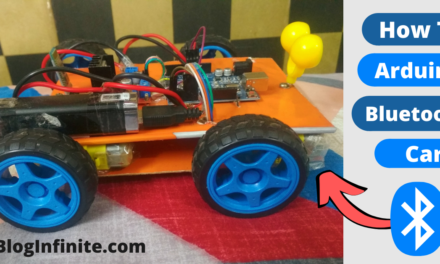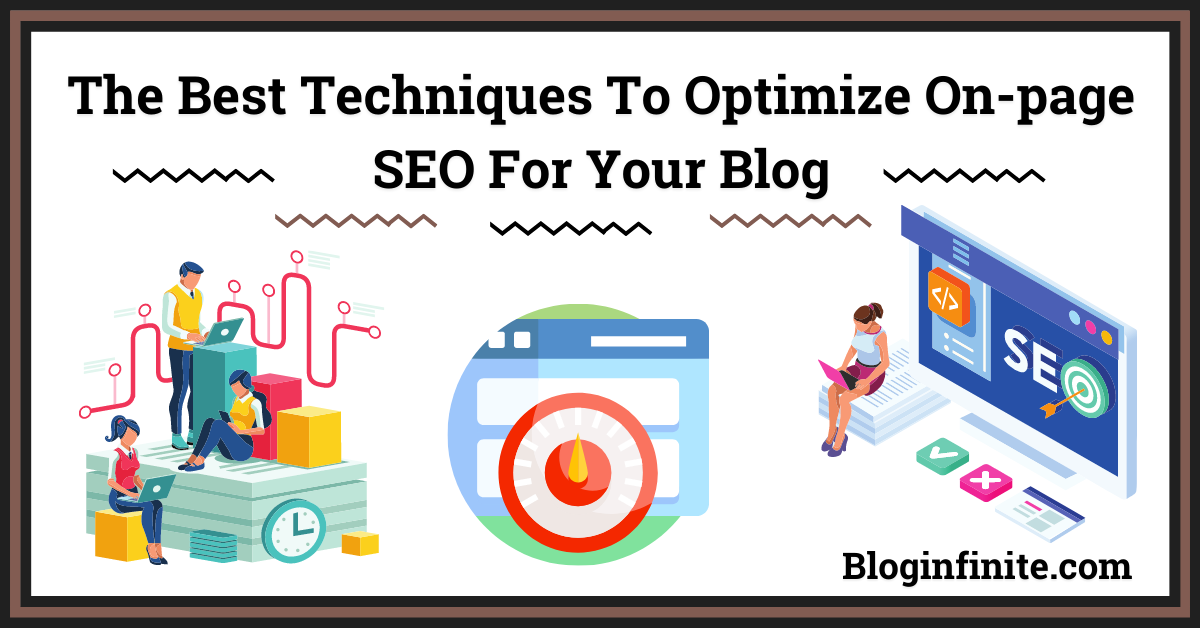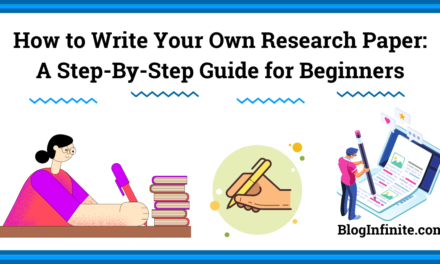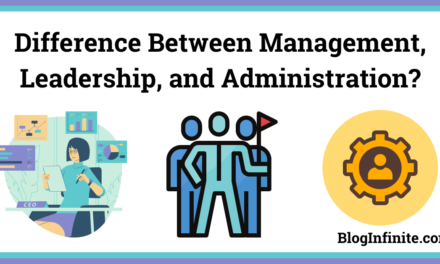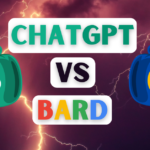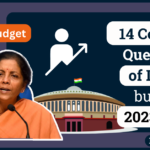Table of Content
The Best Techniques to Optimize On-Page SEO for Your Blog in 2022
When you have your blog, you generally always have to be mindful of the keywords you are using in each piece of content that you write to ensure that you are using the most relevant keywords. Keyword research and proper use of them in your blogs are extremely important for your blog to rank on the first page of search results. Optimizing your content to put in the relevant keywords for them to rank is one very basic on-page SEO* technique.
Introduction
If you have been writing your blog for quite some time, you would have come across the phrase “On-Page SEO technique”. Let us first go through what On-Page SEO means. On-page SEO can be defined as the process of optimizing every individual web page so that it can rank higher on SERPs*. On-page SEO covers many aspects which do not just include content but also technicalities like meta tags* and schema*. In simpler words, On-page SEO refers to the optimization of content and structure of a given web page. To boost the ranking of your web page or blog, follow the list of best on-page SEO techniques given below.
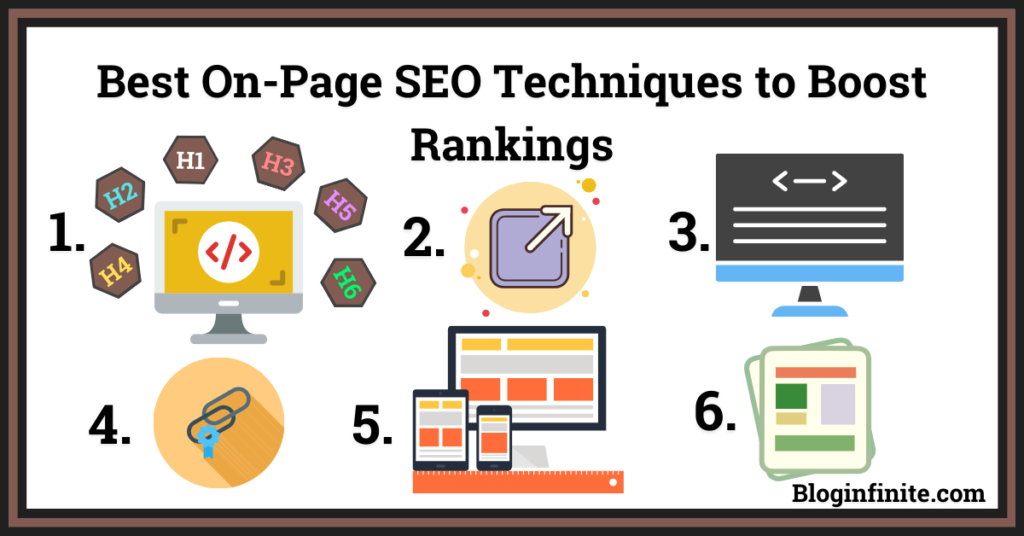
Best On-Page SEO Techniques to Boost Rankings :
1. Optimizing Page Titles and Meta Descriptions:
You must title your blog appropriately. This means that your blog must have a title that is unique and descriptive, meaning it should convey to the reader what your blog is about. The page title comes under the heading tag* and it is an important factor on which the ranking of your page is dependent. The things which you must keep in mind when writing your page title are its length, the number of keywords you use and also using your brand name at the end of the page title. That helps in brand awareness*.
Similar to page titles, meta descriptions also convey to the readers of your blog what it is about. Meta descriptions* are also vital if you want to increase the click-through rate* of your blog. The length of a meta description must always be within 100 to 150 characters and it should be relevant to the webpage content.
2. Using the Right Headings:
As mentioned above, a webpage always contains a header or heading tag. The heading tag is H1 while sub-headings can go from H2 to H6. The heading of your blog must always be unique and contain the keywords relevant to your blog. Ensure that you use interesting headings and sub-headings and that there are relevant keywords and phrases included in them.
3. Proper Formatting and Structure of Content:
Though the format of the content doesn’t necessarily mean that people will read your blog, it is an essential on-page SEO technique as it improves the readability of your blog. The presentation of your content matters as much as the content itself.
Proper formatting of content includes:
- Using bullet points
- Paragraph breaks
- Proper font and font colors
- Proper headings and sub-headings
4. URL Optimization:
Firstly, URL is the address or location of web pages on the Internet, that is, they pinpoint individual content pieces on the web. The format and name of your blog or site can greatly impact your click-through rate. The three most important aspects to optimizing URLs are- the name of the page, the structure of the URL, and the length of the URL. Ensure that the URL of your blog is unique, to boost its ranking.
5. Mobile Friendliness of your Blog:
To create a good online presence, you must gauge how mobile-friendly your content, and blog are. That is because, in most countries, more people use and read blogs on mobiles than on desktops. Smartphone traffic surpasses desktop traffic by a huge margin in several countries. You can use tools like Google Search Console to check how readable your blog is on smartphones and correct any errors that you find.
6. Internal and External Linking:
Internal linking and proper structure of internal linking in your blog will ensure that web crawlers find other pages on your blog. That ultimately helps in distributing link equity* among other web pages on the web. When link equity flows through your entire blog, your page ranking would get boosted.
Coming to external links, it might seem counterproductive to add external links to your blog but you can establish your blog’s domain authority* when you include a relevant website in your blog. External linking is one of the best on-page SEO techniques that you must practice following.
Conclusion
Besides the above-mentioned on-page SEO techniques to boost your blog’s ranking on search engines, you must keep in mind a few more things. Your content must be well-researched, plagiarism-free, and must match the reader’s search intent. Ensure that you are properly using relevant keywords and phrases wherever required. The techniques mentioned above would help you rank on top of SERPs.
Footnotes
Besides the above-mentioned on-page SEO techniques to boost your blog’s ranking on search engines, you must keep in mind a few more things. Your content must be well-researched, plagiarism-free, and must match the reader’s search intent. Ensure that you are properly using relevant keywords and phrases wherever required. The techniques mentioned above would help you rank on top of SERPs.
On-page SEO: It is the practice of optimizing the content of web pages and including relevant keywords to improve traffic on the page and increase its search visibility.
SERPs: Search Engine Results Page or SERP is the first page that shows up when you put a query into a search engine
Meta tags: These are part of the source code of a webpage and they are phrases that describe the content of the page.
Schema: Schema.org is the semantic vocabulary of HTML tags that improves your page’s presentations in SERPs.
Meta Description: This is an element of HTML and it describes the content on a webpage in a summarized form
Heading tags: Header or heading tags are HTML elements that contain relevant keywords and separate the different parts or sub-headings in a webpage
Brand awareness: A self-explanatory term, it describes how much of the target audience recognizes a brand and its products.
Click-through rate: It can be described as the ratio between users who click on a given link and the total number of users who view a link, page, or advertisement.
Link equity: It is a ranking factor of search engines and it is the value that one site provides to another site through backlinks, thus increasing organic rankings on search engines.
Domain authority: DA is a ranking score that shows how likely a page is to show up on SERPs.
If you have any queries regarding this blog you can comment down below and also can contact us on our contact page. If you Want to write for us you can apply for it at Write For Us.



